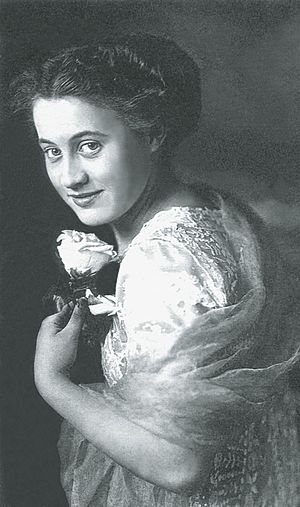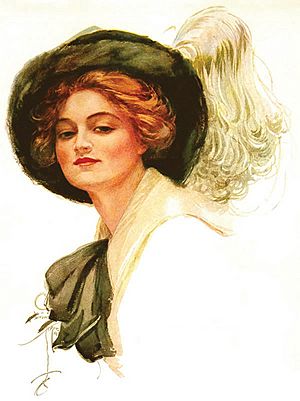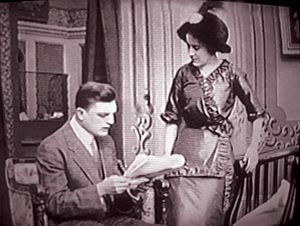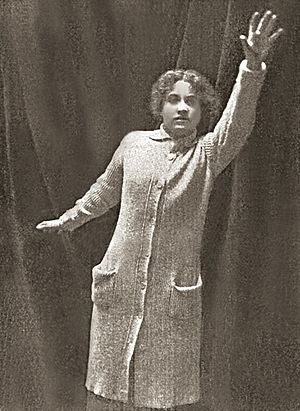Dorothy Gibson facts for kids
Quick facts for kids
Dorothy Gibson
|
|
|---|---|

Gibson in a 1911 publicity photo
|
|
| Born |
Dorothy Winifred Brown
May 17, 1889 Hoboken, New Jersey, U.S.
|
| Died | February 17, 1946 (aged 56) |
| Occupation | Model, actress and singer |
| Years active | 1906–1917 |
| Spouse(s) |
|
Dorothy Gibson (born May 17, 1889 – died February 17, 1946) was an American actress and singer. She was one of the first big stars in silent films. Many people remember her because she survived the sinking of the famous ship, the Titanic. She also starred in the very first movie ever made about the Titanic disaster.
Contents
Early Life and Start in Show Business
Dorothy Winifred Brown was born on May 17, 1889, in Hoboken, New Jersey. Her father passed away when she was only three years old. Later, her mother married John Leonard Gibson, and Dorothy took his last name.
From 1906 to 1911, Dorothy performed on stage. She was a singer and dancer in many theater shows. She even performed on Broadway, which is a famous theater area in New York City. She was also part of the chorus in shows at the Hippodrome Theatre.
Around 1909, Dorothy started posing for a well-known artist named Harrison Fisher. She became one of his favorite models. Her picture appeared on posters, postcards, and even on the covers of popular magazines. These magazines included Cosmopolitan and Saturday Evening Post. People knew her as "The Original Harrison Fisher Girl."
Becoming a Film Star
Dorothy started acting in movies in early 1911. She first worked as an extra, which means she was in the background. Soon, she became a leading lady for Éclair Studios, a new film company. Audiences loved her right away! She quickly became one of the first actresses to be called a "star" in movies.
People praised her natural acting style. She was especially good at comedies. Some of her popular short films were Miss Masquerader (1911) and Love Finds a Way (1912). These movies were made in Fort Lee, New Jersey. At that time, Fort Lee was a very important place for making movies in America.
Dorothy also played an important role in a historical drama called Hands Across the Sea (1911). In this film, she played the character of Molly Pitcher.
The Titanic Disaster and Her Famous Film
Dorothy Gibson's most famous role was playing herself in the movie Saved from the Titanic (1912). This film was based on her real-life experience of surviving the Titanic sinking. It was released just one month after the ship went down. It was the very first movie ever made about the disaster.
The Titanic is the most well-known part of Dorothy's life story. She had been on a six-week vacation in Italy with her mother. They were returning home on the Titanic so Dorothy could make new movies. On the night the ship hit an iceberg, Dorothy and her mother were playing cards with friends. They managed to escape in Lifeboat #7. This was the first lifeboat launched from the ship.
After being rescued by the ship Carpathia and arriving in New York, Dorothy's manager convinced her to act in a movie about the sinking. She not only starred in the film but also helped write the story. She even wore the exact same clothes she had on that night aboard the Titanic! She wore a white silk evening dress with a cardigan and a polo coat.
Saved From the Titanic was a huge success in America, Britain, and France. Sadly, the only known copies of the film were destroyed in a fire in 1914. This loss is considered one of the biggest in silent film history.
Dorothy was one of the highest-paid actresses in the world when she stopped making movies in May 1912. She appeared in about 22 films for Eclair Studios. After leaving movies, she focused on her singing career. She even performed at the Metropolitan Opera House in 1915.
Later Life in Europe
Dorothy moved to Paris, France, to start a new life. She lived there for many years. During World War II, she spent four years in Italy.
In 1944, Dorothy was arrested in Milan, Italy. She was put in the San Vittore prison. However, she managed to escape with the help of a cardinal and a young priest.
Dorothy died of a heart attack in her apartment in Paris in 1946. She was 56 years old. She is buried in Saint-Germain-en-Laye Cemetery.
Her Legacy
Only one of Dorothy Gibson's films still exists today. It is an adventure-comedy called A Lucky Holdup (1912). This film was saved by collectors in 2001 and is now kept at the Library of Congress.
Dorothy Gibson may have inspired characters in other famous works. The character of Susan Alexander in Orson Welles’ movie Citizen Kane (1941) might have been partly based on her. She also inspired a character in a novel by her friend Indro Montanelli. That novel was later made into an award-winning film.
In 2012, actress Sophie Winkleman played Dorothy Gibson in the TV show Titanic. This show marked 100 years since the ship sank.
Filmography
| Year | Title | Role | Notes |
|---|---|---|---|
| 1911 | A Show Girl's Stratagem | ||
| The Angel of the Slums | |||
| Good For Evil | |||
| Hands Across the Sea in '76 | Grace Deane | ||
| Miss Masquerader | Heiress | ||
| The Musician's Daughter | Prima Donna | ||
| The Wrong Bottle | The Bride | ||
| 1912 | Divorcons | The Wife | |
| Mamie Bolton | |||
| Love Finds a Way | Helen | ||
| The Awakening | The Sweetheart | ||
| The Guardian Angel | The Wife | ||
| Getting Dad Married | Ellen | ||
| Bridge | |||
| The Kodak Contest | The Wife | ||
| It Pays to Be Kind | The Sister | ||
| A Living Memory | Her Memory | ||
| Brooms and Dustpans | Kissing Cousin | ||
| The White Aprons | |||
| A Lucky Holdup | Miss Barton | ||
| The Legend of Sleepy Hollow | |||
| The Easter Bonnet | Dora | ||
| Revenge of the Silk Masks | Society Girl | ||
| Saved from the Titanic | Miss Dorothy | Alternative title: A Survivor of the Titanic Screenwriter |
|
| Roses and Thorns |
See also
 In Spanish: Dorothy Gibson para niños
In Spanish: Dorothy Gibson para niños




